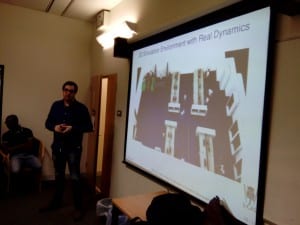The monthly PGRs Research Presentations was held on Thursday 12th May, 2pm, Room MC3108.
This session we had the following presentations:
|
Title: A ROS framework for single antenna RFID tag localisation with mobile robots.
|
||
|
By: George Broughton |
||
|
Over the last few years, RFID technology has evolved to give mobile robots an extra dimension to sense their surroundings. By determining whether certain tags, often fixed to interesting objects, can be read or not, the robot can effectively sense the objects presence. This is not just useful for finding lost objects, but has also been used for activity recognition. Additionally, tags have been used as landmarks within environments to aid with navigation. This presentation looks at the development of a ROS framework for localising RFID tags from a mobile robot. The framework combines several different approaches to make use of the information provided by the tag and from the reader, to estimate possible locations of the tag. This is done by taking the output of the different algorithms, and then combining and feeding them into a densely populated occupancy grid using a bayesian update system to calculate the most probable tag location. Rather than rely on multiple antennas for trilateration, the framework exploits a robot’s ability to move within its environment to seek optimal positions to hone in on a tag. This also has the additional benefit of providing resistance to multipath signal errors. This will lead to a framework that is future-proof, robust, works with multiple models of readers, and can be moulded to suit many needs. |
||
![IMG_20160512_141102[1]](http://postgraduates.blogs.lincoln.ac.uk/files/2016/05/IMG_20160512_1411021-300x225.jpg)
![IMG_20160512_141059[1]](http://postgraduates.blogs.lincoln.ac.uk/files/2016/05/IMG_20160512_1410591-300x225.jpg)
![IMG_20160512_141116[1]](http://postgraduates.blogs.lincoln.ac.uk/files/2016/05/IMG_20160512_1411161-300x225.jpg)





